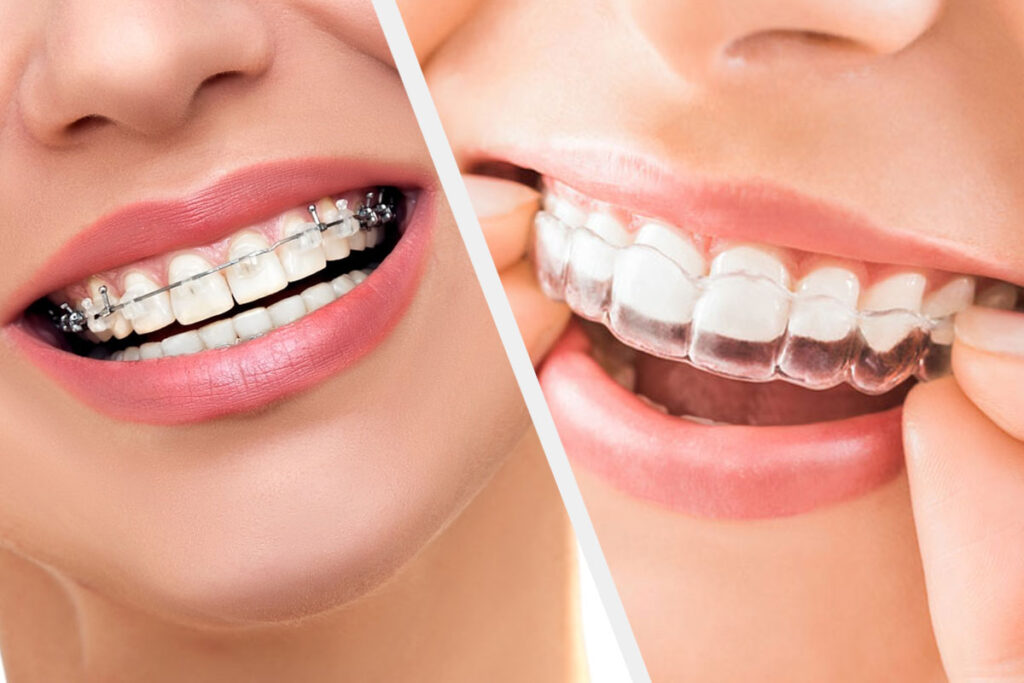Straightening your teeth as an adult can feel like a daunting decision. With advancements in orthodontic treatments, you now have more choices than ever before. Two popular options are invisible aligners and traditional braces. But which one is right for you?
This guide will break down the differences between these options, focusing on their benefits, drawbacks, and how they align with modern dental aesthetics.
What Are Invisible Aligners?
Invisible aligners are clear, plastic trays custom-made to fit over your teeth. They gradually shift your teeth into alignment by applying gentle, consistent pressure. Brands like Invisalign have made these aligners a go-to option for adults seeking discreet orthodontic treatments.
Key Features of Invisible Aligners
- Made from transparent, BPA-free plastic
- Removable for eating and cleaning
- Require a series of trays that are changed every 1-2 weeks
What Are Traditional Braces?
Traditional braces have been used for decades to correct dental misalignments. They consist of metal brackets bonded to your teeth, connected by wires that your orthodontist adjusts periodically.
Key Features of Traditional Braces
- Made from metal or ceramic materials
- Fixed to your teeth for the duration of treatment
- Suitable for addressing complex dental issues
Comparing Invisible Aligners and Traditional Braces
Both options aim to improve your smile, but they differ in various ways. Let’s examine them across key factors to help you make an informed choice.
1. Aesthetic Appeal
- Invisible Aligners:
One of the main reasons adults choose invisible aligners is their nearly invisible appearance. They blend seamlessly with your teeth, making them ideal for maintaining a professional image. - Traditional Braces:
Metal braces are more noticeable and may feel less appealing for adults concerned about dental aesthetics. However, ceramic braces offer a more discreet alternative.
Winner: Invisible aligners
2. Comfort and Convenience
- Invisible Aligners:
These aligners are smooth and less likely to irritate your gums or cheeks. Plus, their removability means you can eat, brush, and floss without restrictions. - Traditional Braces:
Braces can cause initial discomfort and occasional irritation from wires or brackets. They also require extra care during brushing and flossing to avoid plaque buildup.
Winner: Invisible aligners
3. Effectiveness
- Invisible Aligners:
While highly effective for mild to moderate misalignments, aligners may not address complex dental issues as effectively as braces. - Traditional Braces:
These are suitable for all types of alignment problems, including severe overcrowding, large gaps, and bite issues.
Winner: Traditional braces
4. Treatment Time
- Invisible Aligners:
Treatment typically lasts 12-18 months, depending on the complexity of your case. Regular check-ins with your dentist ensure progress. - Traditional Braces:
The average treatment time is 18-24 months, though complex cases may take longer.
Winner: Invisible aligners (for faster cases)
5. Cost
- Invisible Aligners:
The price for invisible aligners can range from £1,500 to £5,000, depending on the brand and complexity of your treatment. - Traditional Braces:
Braces generally cost between £2,000 and £6,000. Metal braces are usually more affordable than ceramic ones.
Winner: Tie – Costs vary based on individual needs.
Advantages of Invisible Aligners
- Discreet Appearance
Their transparency makes them almost undetectable, ideal for adults who want subtle orthodontic corrections. - Removability
Eat your favourite foods without restrictions and maintain excellent oral hygiene effortlessly. - Comfortable Design
No sharp brackets or wires to cause discomfort. - Fewer Dental Visits
Fewer in-person adjustments mean less time spent at the dentist’s office.
Advantages of Traditional Braces
- Effective for Complex Issues
No matter how severe your misalignment, braces can correct it. - Durability
Since they’re fixed, there’s no risk of losing or forgetting them like aligners. - Customisation
Modern braces come with ceramic or coloured options for a more personalised look.
Things to Consider Before Choosing
When deciding between invisible aligners and traditional braces, consider these factors:
- Your Orthodontic Needs: Complex cases may require braces, while mild misalignments can often be treated with aligners.
- Lifestyle: If you prefer flexibility and a low-profile appearance, aligners may be the better option.
- Commitment: Aligners require discipline, as forgetting to wear them for 20-22 hours daily can delay progress.
- Budget: Discuss costs with your dentist to determine which option fits your financial situation.
The Role of Orthodontic Treatments in Dental Aesthetics
Modern orthodontic treatments don’t just align teeth—they also enhance your overall smile. Straight teeth can improve your confidence, facial symmetry, and even your ability to speak and chew effectively. Both braces and aligners contribute to these improvements, making them valuable investments in your oral health.
Choosing between invisible aligners and traditional braces depends on your unique dental needs, lifestyle, and priorities. Aligners offer a discreet and convenient solution, while braces provide unmatched effectiveness for complex cases.
The best way to decide is to consult your dentist or orthodontist, who can evaluate your teeth and recommend the most suitable treatment. Remember, the ultimate goal is a healthier, more confident smile—whichever path you choose!





